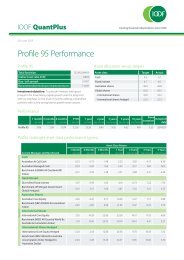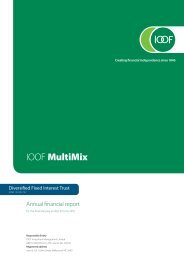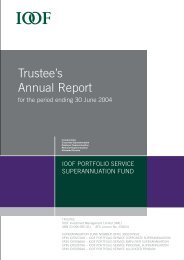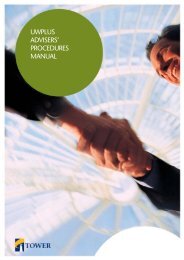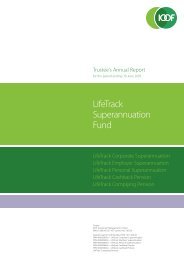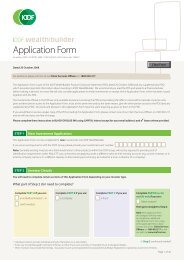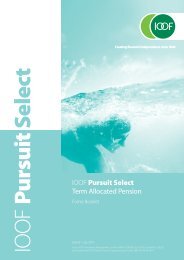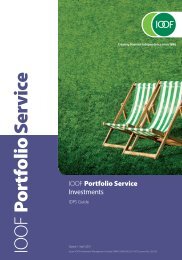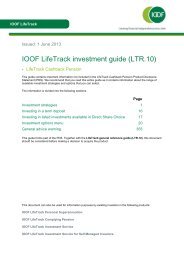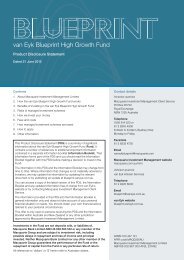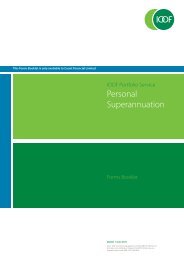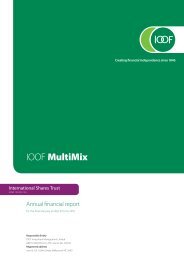annual report 2011
annual report 2011
annual report 2011
You also want an ePaper? Increase the reach of your titles
YUMPU automatically turns print PDFs into web optimized ePapers that Google loves.
IOOF | <strong>annual</strong> <strong>report</strong> <strong>2011</strong><br />
Notes to the financial statements (cont’d)<br />
For the year ended 30 June <strong>2011</strong><br />
Acquisitions prior to 1 July 2004 (date of transition<br />
to IFRS’s)<br />
As part of its transition to IFRS’s, the Group elected to restate<br />
only those business combinations that occurred on or after<br />
1 July 2003. In respect of acquisitions prior to 1 July 2003,<br />
goodwill represents the amount recognised under the Group’s<br />
previous accounting framework, Australian GAAP.<br />
Non-controlling interests<br />
Acquisitions of non-controlling interests are accounted for<br />
as transactions with owners in their capacity as owners<br />
and therefore no goodwill is recognised as a result of such<br />
transactions. The adjustments to non-controlling interests<br />
are based on a proportionate amount of the net assets of the<br />
subsidiary.<br />
(ii)<br />
Subsidiaries<br />
Subsidiaries are entities controlled by the Group. The financial<br />
statements of subsidiaries are included in the consolidated<br />
financial statements from the date that control commences<br />
until the date that control ceases.<br />
Losses applicable to the non-controlling interests in a<br />
subsidiary are allocated to the non-controlling interests even if<br />
doing so causes the non-controlling interests to have a deficit<br />
balance.<br />
(iii) Employee Share Trust<br />
The Group has formed a trust to administer the Group’s<br />
employee share scheme. This trust is consolidated, as the<br />
substance of the relationship is that the trust is controlled by<br />
the Group. Shares held by the IOOF Executive Performance<br />
Share Plan Trust are disclosed as treasury shares and are<br />
deducted from share capital.<br />
(iv) Investments in associates (equity accounted<br />
investees)<br />
Associates are those entities over which the Group has<br />
significant influence, but not control, over the financial and<br />
operating policies. Significant influence is presumed to exist<br />
when the Group holds between 20 and 50 per cent of the<br />
voting power of another entity.<br />
Investments in its associates are accounted for using the<br />
equity method (equity-accounted investees) and are initially<br />
recognised at cost. The cost of the investment includes<br />
transaction costs.<br />
The consolidated financial statements include the Group’s<br />
share of the profit or loss and other comprehensive income,<br />
after adjustments to align the accounting policies with<br />
those of the Group, from the date that significant influence<br />
commences until the date that significant influence ceases.<br />
When the Group’s share of losses exceeds its interest in an<br />
equity accounted investee, the carrying amount of that<br />
interest, including any long-term investments, is reduced to<br />
nil, and the recognition of further losses is discontinued except<br />
to the extent that the Group has an obligation or has made<br />
payments on behalf of the investee.<br />
(v) Transactions eliminated on consolidation<br />
Intra-group balances and transactions, and any unrealised<br />
income and expenses arising from intra-group transactions, are<br />
eliminated in preparing the consolidated financial statements.<br />
Unrealised gains arising from transactions with equity<br />
accounted investees are eliminated against the investment to<br />
the extent of the Group’s interest in the investee. Unrealised<br />
losses are eliminated in the same way as unrealised gains, but<br />
only to the extent that there is no evidence of impairment.<br />
(b) Foreign currency transactions<br />
Transactions in foreign currencies are translated to the<br />
respective functional currencies of the Group entities at<br />
exchange rates at the dates of the transactions. Monetary<br />
assets and liabilities denominated in foreign currencies at the<br />
<strong>report</strong>ing date are retranslated to the functional currency at<br />
the exchange rate at that date. The foreign currency gain or<br />
loss on monetary items is the difference between amortised<br />
cost in the functional currency at the beginning of the period,<br />
adjusted for effective interest and payments during the period,<br />
and the amortised cost in foreign currency translated at the<br />
exchange rate at the end of the year.<br />
Non-monetary assets and liabilities denominated in foreign<br />
currencies that are measured at fair value are retranslated<br />
to the functional currency at the exchange rate at the date<br />
the fair value was determined. Non-monetary items in a<br />
foreign currency that are measured in terms of historical<br />
cost are translated using the exchange rate at the date of<br />
the transaction. Foreign currency differences arising on<br />
the retranslation are recognised in profit or loss, except<br />
for differences arising on the retranslation of available-forsale<br />
equity instruments, which are recognised in other<br />
comprehensive income.<br />
(c) Cash and cash equivalents<br />
Cash and cash equivalents includes cash on hand, deposits<br />
held at call with financial institutions, other short-term, highly<br />
liquid investments with original maturities of three months or<br />
less that are readily convertible to known amounts of cash and<br />
which are subject to an insignificant risk of changes in value<br />
and bank overdrafts.<br />
page 56



